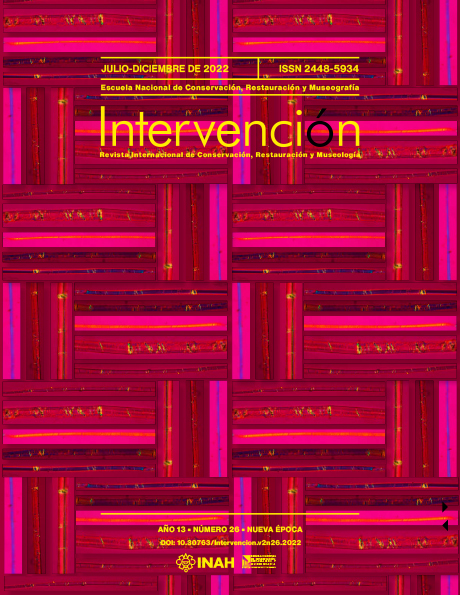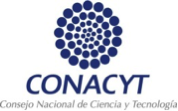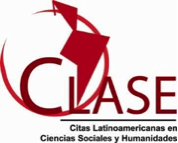Comprehensive Methodology for the Identification of Liberian Flax and Hemp Fibers in the Supports of New Spanish paintings
DOI:
https://doi.org/10.30763/Intervencion.272.v2n26.51.2022Keywords:
Bast fibers, Flax, Hemp, New Spain’s painting, Optical microscopy, Herzog test, Schweitzer reagentAbstract
This research article presents the results from the application of a complementary analysis methodology for the accurate identification of Liberian fibers, specifically linen and hemp, used in the textile supports of easel paintings. The research focuses on six paintings attributed to various representative authors of Novo-Hispanic recognized plastic arts over a wide-ranging time frame spanning from the last third of the XVI century – until the end of the XVII century. During this paper we discuss the continuance detected in the process of intentional selection of canvases used for viceregal paintings in New Spain.
Downloads
References
Aldaba, M., Antó, J., Cayuela D. y Morales C. (2006). Teoría de la birrefringencia en fibras textiles. Boletín INTEXTER del Instituto de Investigación Textil y de Cooperación Industrial (Universidad Politécnica de Catalunya) , 130, 57-62. https://upcommons.upc.edu/bitstream/handle/2099/5671/7Birefringencia.pdf?sequence=1&isAllowed=y
Ángeles, P. y Arroyo, E. (2021). El pintor sabio y la maravilla americana. Pintores y pintura de la maravilla americana (pp. 185-216). Fomento Cultural Citibanamex.
Arroyo, E. (2017). Transparencias y fantasmagorías: la técnica de Cristóbal de Villalpando. En La Transfiguración. Cristóbal de Villalpando, pintor mexicano del Barroco (pp. 1-14). Fomento Cultural Banamex.
Avérous, L. y Le Digabel, F. (2006). Properties of biocomposites based on lignocellulosic fillers. Carbohydr Polym 66(4), 480–493. doi: doi.org/10.1016/j.carbpol.2006.04.004
Azcárraga, R. M., Jacques-Ríos, M.A., Bonfil-Campos, A. y Sandoval-Zapotitla, E. (2010). Atlas de anatomía vegetal. Universidad Nacional Autónoma de México.
Bergfjord, C. y Holst, B. (2010). A procedure for identifying textile bast fibers using microscopy: Flax, nettle/ramie, hemp and jute. Ultramicroscopy 110, 1192-1197. doi: https://doi.org/10.1016/j.ultramic.2010.04.014
Bruquetas, R. (2002). Técnicas y materiales de la pintura española en los Siglos de Oro. Fundación para la Historia del Arte Hispánico.
Cabrera, M. (1756). Maravilla americana y conjunto de raras maravillas, observadas Con la dirección de las Reglas del Arte de la Pintura en la prodigiosa imagen de Nuestra Sra. de Guadalupe de México por don Miguel Cabrera, pintor del Illmo. Sr. D. D. Manuel Joseph Rubio, y Salinas. Dignissimo Arzobispo de Mexico, y de el Consejo de Su Magestad, &c. A quien se la consagra. México, en la Imprenta del Real y más antiguo Colegio de San Ildefonso [reproducción electrónica]. México: Universidad Nacional Autónoma de México, Dirección General de Bibliotecas, 2010. http://132.248.9.195:8080/fondoantiguo1/1205490-652110/JPEG/Index.html.
Campo, G., Bagan, R. y Oriols, N. (2009). Identificació de fibres. Suports tèxtils de pintures. Catalunya: Centre de Restauració de Béns Mobles de la Generalitat de Catalunya.
Catling, D. y Grayson, J. (2004). Identification of Vegetable Fibres. Archetype Books.
Cuadriello, J., Arroyo, E., Zetina, S. y Hernández, E. (2018). Ojos, alas y patas de la mosca. Visualidad, tecnología y materialidad de El martirio de san Ponciano, de Baltasar de Echave Orio. Instituto de Investigaciones Estéticas-Universidad Nacional Autónoma de México.
Elsharnouby, R. y Ahmed, M. (2015). Linen in Ancient Egypt. Journal of the General Union of Arab Archeologists, 15, 1-22. https://jguaa.journals.ekb.eg/article_3087_b97ae56f7bc490c84879a457e8a9ba0a.pdf
Florian, M. L. E., Kronkright, D. P. y Norton, R. E. (1990). The Conservation of Artifacts Made from Plant Materials. The Getty Conservation Institute. https://www.getty.edu/conservation/publications_resources/pdf_publications/pdf/cons_artifacts.pdf
Fu, Y.-B. (2005). Geographic Patterns of rapd Variation in Cultivated Flax. Crop
Science, 45(3), 1084-1091. doi: https://doi.org/10.2135/cropsci2004.0345
García, J. A. (2007). Fibras papeleras. Universidad Politécnica de Catalunya/Ediciones UPC.
Geissman, T. A. (1974). Principios de Química Orgánica [2ª ed.] Barcelona: Editorial Reverté.
Hall, C. E. M. y Davis, M. S. T. (1968). Identificación de fibras textiles. Blume.
Haugan, E. y Holst, B. (2013). Determining the fibrillar orientation of bast fibers with polarized light microscopy: The modified Herzog test (red plate test) explained. Journal of Microscopy, 252(2), 159-168. doi: https://doi.org/10.1111/jmi.12079
Hillig, K. W. (2005). Genetic evidence for speciation in Cannabis (Cannabaceae). Genetic Resoures Crop Evolution, 52, 161–180. doi: https://doi.org/10.1007/s10722-003-4452-y
Houck, M. (2009). Identification of Textile Fibers. Woodhead Publishing.
Iriondo, J. M. (2000). Taxonomía y conservación: dos aproximaciones a un mismo dilema. Portugaliae Acta Biológica, 19(1-4), 1-7. https://dialnet.unirioja.es/servlet/articulo?codigo=2374362#
Juanes, B. D., Marín, C. y Gómez, A. (2008). Aplicaciones de la microscopía óptica y electrónica de barrido. En La ciencia y el arte. Ciencias experimentales y conservación del Patrimonio Histórico Español (pp. 68-80). Instituto del Patrimonio Histórico Español-Ministerio de Cultura.
Kvavadze, E., Bar-Yosef, O., Belfer-Cohen, A., Boaretto, E., Jakeli, N., Matskevich, Z. y Meshveliani, T. (2009). 30,000-Year-Old Wild Flax Fibers. Science, 325(5946), 1359-1359. doi: https://www.science.org/doi/10.1126/science.1175404
Lukesova, H. y Holst, B. (2020). Is Cross‐Section Shape a Distinct Feature in Plant Fibre Identification?, Archaeometry, 63(1), 216-226. doi: 10.1111/arcm.12604
Luniak, B. (1953). The Identification of Textile Fibres. Qualitative and Quantitative
Analysis of Fibre Blends. Pitman & Sons.
Mattews, J. M. (1931). The Textile Fibers: Their Physical, Microscopical and Chemical Properties. John Wiley and Sons.
Mirambell, L. y Sánchez, F. (1986). Material arqueológico de origen orgánico: textiles. México. Instituto Nacional de Antropología e Historia.
Mishler, B. D. y Luna, E. de (1997). Sistemática filogenética y el concepto de especie. Boletín de la Sociedad Botánica, 60, 45-57. doi: https://doi.org/10.17129/botsci.1518
Ramírez, R. (2014). El hilado y el tejido en la época prehispánica. Arqueología Mexicana, Edición especial 55, 68-69.
Strasburger, E., Noll, F., Shenck, H. y Schimper, A. F. W. (2004). Tratado de botánica. 35 Edición (Edición actualizada por Peter Sitte, Elmar W. Weiler, Joachim W. Kadereit, Andreas Bresinsky y Christian Körner). Ediciones Omega.
Sumano, R. (2010). Estudio de la técnica de manufactura de los soportes textiles de la pintura de caballete en México, siglos xvii al xix (Tesis de licenciatura en Restauración de Bienes Muebles). Escuela Nacional de Conservación, Restauración y Museografía-Instituto Nacional de Antropología e Historia.
Suomela, J. A., Vajanto, K. y Räisänen, R. (2017). Seeking Nettle Textiles-Utilizing a Combination of Microscopic Methods for Fibre Identification. Studies in Conservation, 63(7), 412-422. doi: https://doi.org/10.1080/00393630.2017.1410956
Von Bergen, W. y Krauss, W. (1942). Textile Fiber Atlas: A Collection of Photomicrographs of Common Textile Fibers. American Wool Handbook Company.
Zárate, E. (2020). Apéndice documental. Historias de pincel. Pintura y retablos del siglo xvi en la Nueva España (503-529). Instituto de Investigaciones Estéticas-Universidad Nacional Autónoma de México.
Additional Files
Published
How to Cite
Issue
Section
License
Copyright (c) 2023 Instituto Nacional de Antropología e Historia (INAH)

This work is licensed under a Creative Commons Attribution-NonCommercial 4.0 International License.

Atribución-NoComercial 4.0 Internacional
https://creativecommons.org/licenses/by-nc/4.0/deed.es
Usted es libre de:
- Compartir — copiar y redistribuir el material en cualquier medio o formato
- Adaptar — remezclar, transformar y construir a partir del material
Bajo los siguientes términos:
-
Atribución — Usted debe dar crédito de manera adecuada, brindar un enlace a la licencia, e indicar si se han realizado cambios. Puede hacerlo en cualquier forma razonable, pero no de forma tal que sugiera que usted o su uso tienen el apoyo de la licenciante.
-
No Comercial — Usted no puede hacer uso del material con propósitos comerciales.




















